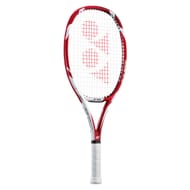Although the actual origin of tennis is still debatable, there is no doubt that the sport has existed since a long time ago. Most historians credit the origin of the game to 11th or 12th century French monks who began playing with a crude handball against the walls. It was called as ‘jeu de paume’ meaning ‘game of the hand’. The earlier version of the game was more or less similar to the game of squash. However, tennis has undergone a lot of changes since the early days and the modern game has developed into a fast and aggressive one that centers around putting the opponent on the back foot right from the service itself.
One of the important aspects to have shaped the sport as it is today has to do with the advancement in the racquet technology over the years. For the most part, racquet technology can be divided into 3 eras which are wooden, steel / aluminum and graphite respectively.
Wooden racquets:
Major Walter C. Wingfield registered his patent for the rules and equipment of outdoor lawn tennis in 1874. This is generally considered to be the first version of today’s game. From this period till the end of the wooden era almost 100 years later, there were only minor changes that took place in the wooden racquets. These wooden racquets were mostly made up of ash and beech. With improvements in technology and in the strings the racquets did improve a little but they mostly remained heavy (weighing between 370-400 grams) and had small heads (around 65 square inches).
While the sport was being played during the wooden era, players needed to rely a lot more on their touch. With heavier racquets, the ball speeds were faster and as the racquets also had much smaller head sizes, the sweet spot was also smaller. This meant that players had to depend a lot more on their control. A fine example would be that of Ken Rosewall who had a great touch game and such players usually were able to rise to the top at that time. As far as today’s power game is concerned, Rosewall could have found himself struggling to make an impact.
The 1970s were dominated mainly by wooden racquets from Dunlop, Wilson, Slazenger and Spalding out of which the Dunlop Maxply Fort and the Wilson Jack Kramer were classic ones. The racquets were generally heavy with extremely small sweet spots. However, compared to the modern day tennis racquets, the wooden ones were cumbersome and lacked power.
Steel / aluminum racquets:
It wasn’t until 1967 that there was any radical change as far as manufacturing racquets were concerned. This was the period when Wilson Sporting Goods introduced the first popular metal racquet called the T2000. This racquet was stronger and also lighter than the wooden racquets and it started becoming famous amongst players.
With the introduction of the steel racquets, racquet technology was thrust into the forefront and many developments started to take place. The steel construction enabled consistency of playing characteristics. It is interesting to note that at the same time Borg was experimenting with a wooden racquet reinforced with modern material for extra stiffness. Steel racquets had a longer lifespan and successfully increased the stiffness of the racquet without adding weight. These racquets generally weighed around 350 grams.
Jimmy Connors became the most famous person to start using the steel racquets. He played at the top of men’s professional tennis during the 1970s with the T2000. However, this racquet had a small-headed steel frame with a long throat. Connors was very successful during his victory in the Wimbledon final over Ken Rosewall who was still playing with wooden racquets.
Afterwards, in 1976, Howard Head who was working with the Prince brand introduced the Prince Classic as the first oversized racquet to have gained widespread popularity. The Prince Classic and the Prince Pro were both in demand at that time and they featured aluminum frames with a head size approximately 50% more than the standard 65 square inch wooden racquet.
The light weight and the huge sweet spot made playing much easier for non-advanced players. However, for advanced players, the mixture of flexibility and power in the frames made it very difficult to judge where the ball would end up, hence, advanced players required a stiffer frame.
Graphite racquets:
The two main components when it comes to racquet material are stiffness and light weight. The most common choice for adding stiffness to racquets without adding weight is the use of graphite. One of the most famous early graphite racquets was the Dunlop Max 220G used by both John McEnroe and Steffi Graf. It weighed around 350 grams during the 1980s. Over the years, graphite racquets have gotten even lighter with the normal weight at about 300 grams while some can even be as light as 200 grams.
The modern game is characterized by power and spin. With the standard racquet heads in the region of 100 square inches or more, the sweet spot on offer is a lot more. Due to this, the amount of top spin that players can generate is also much more and this is contributing to the modern style of power tennis.
With the racquets getting lighter and lighter by the day, players are able to swing the racquet at a faster pace than before, generating higher impact speeds and ultimately resulting in faster ball speeds. Faster shots are less likely to be returned than slower shots and hence, the modern game is all about taking the time away from your opponent. The advances in racquet technology today have enabled players to slug it out from the baseline with a lot of power all the while retaining control of their shots. As with more power, the ball tends to go further, and to counter this, heavy topspins are often used so as to keep the ball in play.
In short, the game of tennis has changed since the early days. The previous eras were dominated by the soft touches and amazingly controlled volleys. There was a slow pace about the entire affair, but all that has now taken back stage and one of the important contributing factors for this has been the evolution of racquets.
Upcoming technology:
Evolution via technology is a never ending process. The same holds true for the game of tennis. The latest on the tennis racquet technology looks into a concept called as ‘smart racquets’. Babolat, one of the leading tennis equipment manufacturers has come up with racquets with computer technology built into the handle. This racquet gathers data through sensors and chips fitted in the handle. The technology is said to be useful in understanding why a shot went wide or hit the net among other such details. Thus, it is safe to conclude that technology will still be playing a vital role in the years to come with regards to the development of tennis racquets.
What are Andre Agassi-Steffi Graf’s children doing now? Everything to know about Jaz & Jaden Agassi



